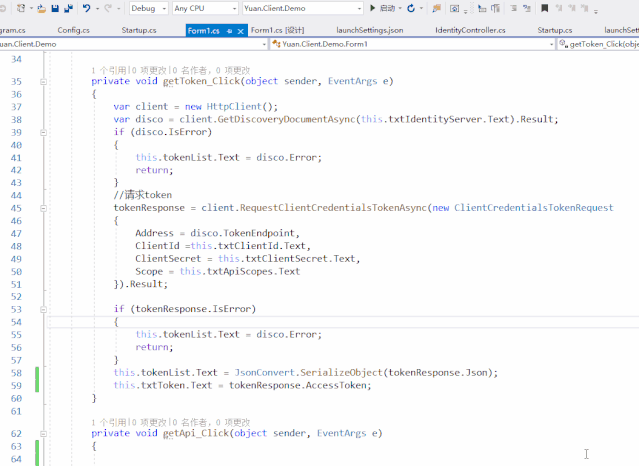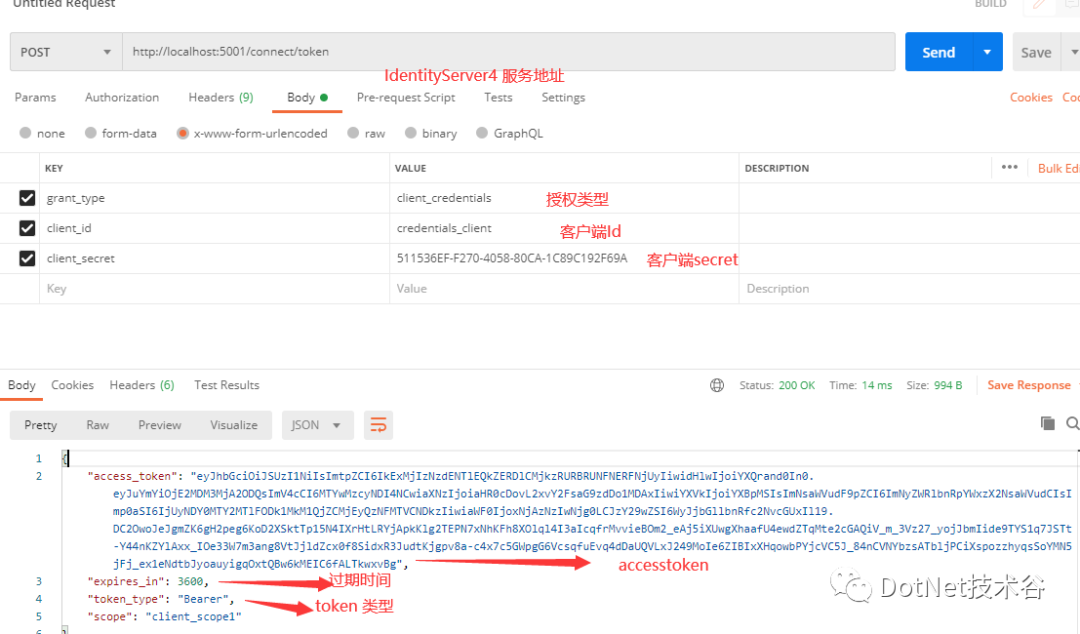一、前言
从上一篇关于 快速搭建简易项目中,通过手动或者官方模板的方式简易的实现了我们的IdentityServer授权服务器搭建,并做了相应的配置和UI配置,实现了获取Token方式。
而其中我们也注意到了三点就是,有哪些用户(users)可以通过哪些客户端(clents)来访问我们的哪些API保护资源 (API)。
所以在这一篇中,我们将通过多种授权模式中的客户端凭证模式进行说明,主要针对介绍「IdentityServer」保护API的资源,客户端认证授权访问API资源。.

二、初识
Client Credentials 客户端凭证模式:客户端(Client)请求授权服务器验证,通过验证就发access token,Client直接以已自己的名义去访问Resource server的一些受保护资源。
❝用户使用这个令牌访问资源服务器,当令牌失效时使用刷新令牌去换取新的令牌(刷新令牌有效时间大于访问令牌,刷新令牌的功能不做详细介绍)
❞
这种方式给出的令牌,是针对第三方应用的,而不是针对用户的,即有可能多个用户共享同一个令牌。
2.1 适用范围
这种模式一般只用在服务端与服务端之间的认证
适用于没有前端的命令行应用,即在命令行请求令牌
认证服务器不提供像用户数据这样的重要资源,仅仅是有限的只读资源或者一些开放的API。例如使用了第三方的静态文件服务,如Google Storage或Amazon S3。这样,你的应用需要通过外部API调用并以应用本身而不是单个用户的身份来读取或修改这些资源。这样的场景就很适合使用客户端证书授权。
2.2 Client Credentials流程:
+---------+ +---------------+
| | | |
| |>--(A)- Client Authentication --->| Authorization |
| Client | | Server |
| |<--(B)---- Access Token ---------<| |
| | | |
+---------+ +---------------+
「客户端凭据许可流程描述」
(A)客户端与授权服务器进行身份验证并向令牌端点请求访问令牌。
(B)授权服务器对客户端进行身份验证,如果有效,颁发访问令牌。
2.2.1 过程详解
访问令牌请求
| 参数 | 是否必须 | 含义 |
|---|---|---|
| grant_type | 必需 | 授权类型,值固定为“client_credentials”。 |
| scope | 可选 | 表示授权范围。 |
示例:客户端身份验证两种方式
1、Authorization: Bearer base64(resourcesServer:123)
2、client_id(客户端标识),client_secret(客户端秘钥)。
POST /token HTTP/1.1
Host: authorization-server.com
grant_type=client_credentials
&client_id=xxxxxxxxxx
&client_secret=xxxxxxxxxx
2.2.2 访问令牌响应
刷新令牌不应该包含在内。
HTTP/1.1 200 OK
Content-Type: application/json;charset=UTF-8
Cache-Control: no-store
Pragma: no-cache
{
"access_token":"2YotnFZFEjr1zCsicMWpAA",
"token_type":"Bearer",
"expires_in":3600,
"scope":"server"
}
三、实践
❝在示例实践中,我们将创建一个授权访问服务,定义一个API和要访问它的客户端,客户端通过「IdentityServer」上请求访问令牌,并使用它来访问API。
❞
3.1 搭建 Authorization Server 服务
❝搭建认证授权服务
❞
3.1.1 安装Nuget包
❝❞
IdentityServer4程序包
3.1.2 配置内容
建立配置内容文件Config.cs
public static class Config
{
public static IEnumerable<IdentityResource> IdentityResources =>
new IdentityResource[]
{
new IdentityResources.OpenId(),
new IdentityResources.Profile(),
};
public static IEnumerable<ApiScope> ApiScopes =>
new ApiScope[]
{
new ApiScope("client_scope1")
};
public static IEnumerable<ApiResource> ApiResources =>
new ApiResource[]
{
new ApiResource("api1","api1")
{
Scopes={"client_scope1" }
}
};
public static IEnumerable<Client> Clients =>
new Client[]
{
// m2m client credentials flow client
new Client
{
ClientId = "credentials_client",
ClientName = "Client Credentials Client",
AllowedGrantTypes = GrantTypes.ClientCredentials,
ClientSecrets = { new Secret("511536EF-F270-4058-80CA-1C89C192F69A".Sha256()) },
AllowedScopes = { "client_scope1" }
},
};
}
3.1.3 注册服务
在startup.cs中ConfigureServices方法添加如下代码:
public void ConfigureServices(IServiceCollection services)
{
var builder = services.AddIdentityServer();
// .AddTestUsers(TestUsers.Users);
// in-memory, code config
builder.AddInMemoryIdentityResources(Config.IdentityResources);
builder.AddInMemoryApiScopes(Config.ApiScopes);
builder.AddInMemoryApiResources(Config.ApiResources);
builder.AddInMemoryClients(Config.Clients);
// not recommended for production - you need to store your key material somewhere secure
builder.AddDeveloperSigningCredential();
}
3.1.4 配置管道
在startup.cs中Configure方法添加如下代码:
public void Configure(IApplicationBuilder app, IWebHostEnvironment env)
{
if (env.IsDevelopment())
{
app.UseDeveloperExceptionPage();
}
app.UseRouting();
app.UseIdentityServer();
app.UseEndpoints(endpoints =>
{
endpoints.MapGet("/", async context =>
{
await context.Response.WriteAsync("Hello World!");
});
});
}
以上内容是快速搭建简易IdentityServer项目服务的方式,具体说明可以看上一篇的内容。
3.2 搭建API资源
❝实现对API资源进行保护
❞
3.2.1 快速搭建一个API项目
3.2.2 安装Nuget包
❝IdentityServer4.AccessTokenValidation 包
❞
3.2.3 注册服务
在startup.cs中ConfigureServices方法添加如下代码:
public void ConfigureServices(IServiceCollection services)
{
services.AddControllersWithViews();
services.AddAuthorization();
services.AddAuthentication("Bearer")
.AddIdentityServerAuthentication(options =>
{
options.Authority = "http://localhost:5001";
options.RequireHttpsMetadata = false;
options.ApiName = "api1";
});
}
AddAuthentication把Bearer配置成默认模式,将身份认证服务添加到DI中。
AddIdentityServerAuthentication把IdentityServer的access token添加到DI中,供身份认证服务使用。
3.2.4 配置管道
在startup.cs中Configure方法添加如下代码:
public void Configure(IApplicationBuilder app, IWebHostEnvironment env)
{
if (env.IsDevelopment())
{
app.UseDeveloperExceptionPage();
}
app.UseRouting();
app.UseAuthentication();
app.UseAuthorization();
app.UseEndpoints(endpoints =>
{
endpoints.MapDefaultControllerRoute();
});
}
UseAuthentication将身份验证中间件添加到管道中;
UseAuthorization 将启动授权中间件添加到管道中,以便在每次调用主机时执行身份验证授权功能。
2.5 添加API资源接口
[Route("api/[Controller]")]
[ApiController]
public class IdentityController:ControllerBase
{
[HttpGet("getUserClaims")]
[Authorize]
public IActionResult GetUserClaims()
{
return new JsonResult(from c in User.Claims select new { c.Type, c.Value });
}
}
在IdentityController 控制器中添加 [Authorize] , 在进行请求资源的时候,需进行认证授权通过后,才能进行访问。
3.3 搭建Client客户端
❝实现对API资源的访问和获取资源
❞
3.3.1 搭建一个窗体程序
3.3.2 安装Nuget包
❝「IdentityModel」 包
❞
3.3.3 获取令牌
❝客户端与授权服务器进行身份验证并向令牌端点请求访问令牌。授权服务器对客户端进行身份验证,如果有效,颁发访问令牌。
❞
「IdentityModel」 包括用于发现 「IdentityServer」 各个终结点(EndPoint)的客户端库。
我们可以使用从 「IdentityServer」 元数据获取到的Token终结点请求令牌:
private void getToken_Click(object sender, EventArgs e)
{
var client = new HttpClient();
var disco = client.GetDiscoveryDocumentAsync(this.txtIdentityServer.Text).Result;
if (disco.IsError)
{
this.tokenList.Text = disco.Error;
return;
}
//请求token
tokenResponse = client.RequestClientCredentialsTokenAsync(new ClientCredentialsTokenRequest
{
Address = disco.TokenEndpoint,
ClientId =this.txtClientId.Text,
ClientSecret = this.txtClientSecret.Text,
Scope = this.txtApiScopes.Text
}).Result;
if (tokenResponse.IsError)
{
this.tokenList.Text = disco.Error;
return;
}
this.tokenList.Text = JsonConvert.SerializeObject(tokenResponse.Json);
this.txtToken.Text = tokenResponse.AccessToken;
}
3.3.4 调用API
❝要将Token发送到API,通常使用HTTP Authorization标头。这是使用
❞SetBearerToken扩展方法完成。
private void getApi_Click(object sender, EventArgs e)
{
//调用认证api
if (string.IsNullOrEmpty(txtToken.Text))
{
MessageBox.Show("token值不能为空");
return;
}
var apiClient = new HttpClient();
//apiClient.SetBearerToken(tokenResponse.AccessToken);
apiClient.SetBearerToken(this.txtToken.Text);
var response = apiClient.GetAsync(this.txtApi.Text).Result;
if (!response.IsSuccessStatusCode)
{
this.resourceList.Text = response.StatusCode.ToString();
}
else
{
this.resourceList.Text = response.Content.ReadAsStringAsync().Result;
}
}
❝以上展示的代码有不明白的,可以看本篇项目源码,项目地址为 :
❞
3.4 效果
3.4.1 项目测试

3.4.2 postman测试

四、问题

「注意,如果你的代码没问题,但是依然报错,比如“无效的scope”,“Audience validation failed”等问题。」
在3.1.x 到 4.x 的变更中,ApiResource 的 Scope 正式独立出来为 ApiScope 对象,区别ApiResource 和 Scope的关系, Scope 是属于ApiResource 的一个属性,可以包含多个Scope。
所以在配置ApiResource、ApiScope、Clients中,我们有些地方需要注意:
在3.x版本中
public static IEnumerable<ApiResource> GetApiResources()
{
return new[] { new ApiResource("api1", "api1") };
}
改成4.x版本为
public static IEnumerable<ApiResource> ApiResources =>
new ApiResource[]
{
new ApiResource("api1","api1")
{
Scopes={"client_scope1" }
}
};
public static IEnumerable<ApiScope> ApiScopes =>
new ApiScope[]
{
new ApiScope("client_scope1")
};
因此,
这里比之前3.x版本多了一个添加ApiScopes的方法:
builder.AddInMemoryApiScopes(Config.ApiScopes);
因为接下来有要保护的API资源,所以需要添加一行:
builder.AddInMemoryApiResources(Config.ApiResources);
❝❞
如果在4.x版本中,不添加ApiScopes方法的话,在获取token令牌的时候一直“无效的scope”等错误 在授权访问保护资源的时候,如果 ApiResource中不添加Scopes, 会一直报Audience validation failed错误,得到401错误,所以在4.x版本中写法要不同于3.x版本
所以,需要注意的是4.x版本的ApiScope和ApiResource是分开配置的,然后在ApiResource中一定要添加Scopes。
五、总结
-
本篇主要以「客户端凭证模式」进行授权,我们通过创建一个认证授权访问服务,定义一个API和要访问它的客户端,客户端通过「IdentityServer」上请求访问令牌,并使用它来控制访问API。 -
在文中可能出现的问题,我们通过查找解决,以及前后版本之间的差异,并总结说明问题。 -
在后续会对其中的其他授权模式,数据库持久化问题,以及如何应用在API资源服务器中和配置在客户端中,会进一步说明。 -
如果有不对的或不理解的地方,希望大家可以多多指正,提出问题,一起讨论,不断学习,共同进步。 -
项目地址 https://github.com/i3yuan/Yuan.IdentityServer4.Demo/tree/main/DiffAuthMode/ClientCredentials
